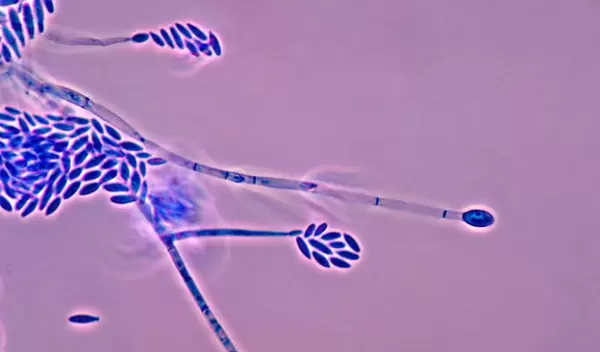
Forming ice: There's a fungal protein for that
The way ice forms is much more interesting than expected. This basic physical process, among the most common in nature, remains somewhat mysterious despite decades of scientific scrutiny.
Now, U.S. National Science Foundation-supported research by scientists at the University of Utah, Boise State University and other institutions is shedding light on the role of biological agents — produced by fungi — in ice formation.
Contrary to what is commonly thought, water won't necessarily freeze at 0 degrees Celsius (32 degrees Fahrenheit) because of the energy barrier inherent in phase transitions.
Completely pure water won't freeze until it cools to as low as -46 C. That's because water molecules require particles on which to build the crystals that lead to ice, a process called nucleation. Organisms have evolved various ways to control ice formation as an adaptation to survive in cold environments.
That means the most efficient ice-nucleating particles are biological in origin, produced in bacteria, fungi and even insects, but the molecular basis and precise mechanisms of "biological ice nuclei" has not been well understood.
Valeria Molinero, a theoretical chemist at the University of Utah, is at the forefront of sorting out this mystery, which holds potential implications for improving scientists' understanding of how life affects precipitation and climate.
In a recent study, an international team of researchers, including Molinero and Konrad Meister of Boise State, explored the characteristics and properties of fungal ice nucleators, revealing that they are made up of small protein subunits and play a role in both promoting and inhibiting ice growth.
"They are proteins that are excreted to the environment, and these particles are extremely effective for ice nucleation," said Molinero. "But the way the organism benefits from these ice nucleation abilities is not known and it doesn't exist in all the possible variants of the organism. We don't know why they form ice or whether there's an advantage."
The multidisciplinary team homed in on a species of fungus called Fusarium acuminatum and discovered it produces ultra-minute proteins that combine into larger particles. Their findings are published in the journal Proceedings of the National Academy of Sciences.
Bacterial and fungal proteins can spur ice formation at temperatures as warm as -10 to -2 degrees. Some bacteria are so effective at promoting ice that ski areas use them for snowmaking.
According to the study, the ecological advantages of ice nucleation and its role in cloud formation and precipitation are not yet fully understood, posing a significant gap in understanding the interplay between climate and life. The research could lead to improving the efficiency of food-freezing process, snowmaking or cloud seeding.
With the team's discoveries come many more questions, however, such as why and how these proteins combine. "The other question is whether they're doing this on purpose or is it just that there's a protein that they produce for something else, but it has this property," said Molinero.
Resolving these fundamental questions will require teamwork, bringing together investigators with expertise in various areas of chemistry, biophysics and biology.
